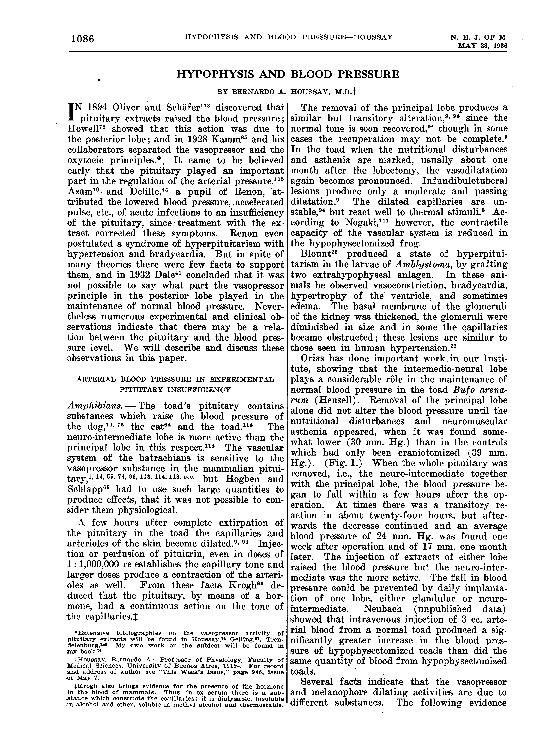Artículo
Hypophysis and blood pressure
Fecha de publicación:
1936
Editorial:
Massachusetts Medical Society
Revista:
New England Journal of Medicine
ISSN:
0028-4793
Idioma:
Inglés
Volumen:
214
Número:
22
Páginas:
1086-1092
Subtipo:
Artículo científico
Financiación:
Fundacion Williams.;
Fundación de Instituto de Biología y Medicina Experimental;
Consejo Nacional de Investigaciones Científicas y Técnicas;
Nombre del Proyecto:
Proyecto Houssay y Leloir
Clasificación temática:
Resumen
The posterior pituitary lobe contains vasopressor substances, which in amphibians play a very important role in the maintenance of the blood pressure and arterial and capillary tone. Small quantities of similar substances exist in the principal lobe of the toad, but removal of this lobe causes a lowering of the blood pressure only after asthenia has developed. In the rat, dog and man pituitary insufficiency is accom- panied by lowered blood pressure; it is not clear whether this is due to lack of one or both lobes, but it seems more particularly due to lack of the anterior lobe (central or peripheral vascular asthenia). The existence of raised blood pressure in acromegaly has not been well established, since the blood pressure is frequently normal in these cases. On the other hand hypertension is a constant and prominent symptom in the pitui- tary basophilism syndrome of Cushing, though whether this is due to pituitary or adrenal hy- persecretion or to a secondary or associated factor, is not yet clear. The evidence put forward to demonstrate that hyperactivity of the posterior pituitary lobe is the causal factor in eclampsia and in essen- tial hypertension is contradictory and inconclusive. In contradistinction to the medulla the diencephalon is not essential for the maintenance of blood pressure in acute experiments, nor has it been proved that increase in blood pressure due to lesions or stimulation of this region is accompanied by hypersecretion of the posterior pituitary.
Archivos asociados
Licencia
Identificadores
Colecciones
Recursos continuos (Bernardo Alberto Houssay)
Recursos continuos (Bernardo Alberto Houssay)
Recursos continuos (Bernardo Alberto Houssay)
Citación
Houssay, Bernardo Alberto; Hypophysis and blood pressure; Massachusetts Medical Society; New England Journal of Medicine; 214; 22; 1936; 1086-1092
Compartir
Altmétricas




